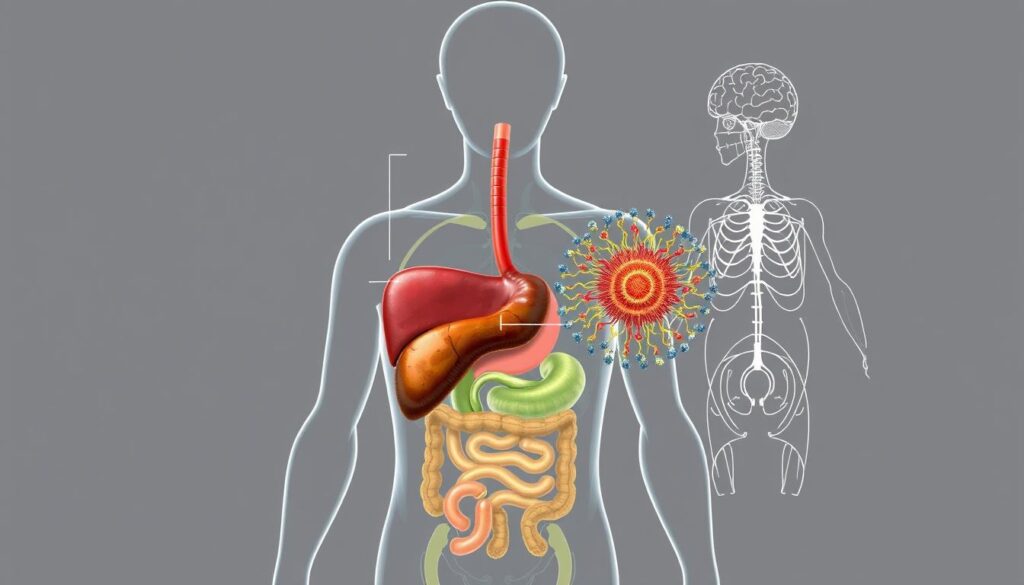Are you looking for a flexible eating approach that can help boost your metabolism and support your weight loss goals? Intermittent fasting has become increasingly popular for its potential to improve overall health and aid in weight loss.
Unlike traditional diets that focus on what to eat, fasting primarily addresses when to eat by establishing specific eating windows. This comprehensive guide will walk you through creating an effective meal plan that works with your lifestyle and health objectives.
By exploring the science behind why this approach works and various fasting methods, you’ll be able to maximize your results and achieve a healthier body.
Key Takeaways
- Understand the benefits of intermittent fasting for weight loss and overall health.
- Learn how to create an effective eating window that suits your lifestyle.
- Discover various fasting methods to maximize your results.
- Get practical tips on meal planning to support your health objectives.
- Achieve a healthier body through a sustainable fasting routine.
Understanding Intermittent Fasting
Intermittent fasting has gained popularity as a dietary approach for weight management and overall health improvement. It’s not just about what you eat, but when you eat.
What Is Intermittent Fasting?
Intermittent fasting involves alternating intervals of fasting and eating. The two most common methods are the 16/8 method, where you fast for 16 hours and eat within an 8-hour window, and the 5:2 method, where you eat normally for 5 days and restrict calories to 500-600 on the other 2 days. This diet is more about an eating pattern than a traditional diet.
How It Affects Your Body
When you fast, your body shifts from using glucose as its primary energy source to burning stored fat, which can lead to weight management benefits. Beyond weight control, intermittent fasting affects numerous bodily systems, including hormone regulation, cellular repair processes, and metabolic function. By giving your body extended breaks from processing food, you trigger various beneficial physiological responses that can enhance overall health.
The Science Behind Intermittent Fasting
When you embark on an intermittent fasting regimen, your body undergoes significant changes at the cellular level, impacting your metabolism and energy production. These changes are crucial to understanding how intermittent fasting can be effective for weight loss and overall health improvement.
Metabolic Changes During Fasting
During fasting periods, your body transitions from relying on readily available glucose to burning stored fat for energy. After approximately 12 hours of fasting, your glycogen stores deplete, and your body begins a process called ketosis, converting fat into ketones for fuel. This metabolic switch can increase fat oxidation and may help reduce overall body fat percentage when maintained consistently.

Hormonal Effects
Fasting triggers important hormonal changes, particularly affecting insulin levels, which drop significantly during fasting periods. Lower insulin levels make stored body fat more accessible for energy use and can improve insulin sensitivity over time. Additionally, human growth hormone (HGH) levels increase during fasting, helping preserve muscle mass and potentially enhancing fat burning.
Popular Intermittent Fasting Methods
When it comes to intermittent fasting, one size doesn’t fit all. Different methods cater to various lifestyles and preferences, making it essential to choose the one that suits you best.
16/8 Method
The 16/8 method is the most popular approach, involving a daily 16-hour fast with an 8-hour eating window, typically from noon to 8 PM. This time-restricted eating pattern is relatively easy to implement and often aligns naturally with sleep schedules, making it sustainable for many people.
5:2 Method
The 5:2 method takes a weekly approach, with normal eating for five days and restricted calorie intake (about 500-600 calories) on two non-consecutive days. This approach offers more flexibility on eating days while still providing metabolic benefits from the fasting periods.
Eat-Stop-Eat
The Eat-Stop-Eat method involves a complete 24-hour fast once or twice per week, from dinner one day to dinner the next day. While potentially more challenging, this method can be effective for those who prefer less frequent but more intensive fasting periods.
Each method has unique advantages, and the best choice depends on your lifestyle, preferences, and how your body responds to fasting. No matter the intermittent fasting pattern, the key is what you eat when not fasting.
Benefits of Intermittent Fasting
By incorporating intermittent fasting into your lifestyle, you can experience a range of health benefits. Intermittent fasting has been shown to have a positive impact on various aspects of health, from weight management to improved metabolic function.
Weight Loss and Fat Burning
Intermittent fasting naturally reduces calorie intake and enhances fat-burning mechanisms, leading to weight loss. It specifically targets visceral fat around internal organs more effectively than some traditional diets.
Improved Blood Sugar Control
Fasting periods allow insulin levels to drop, improving insulin sensitivity and blood sugar regulation. This reduces the risk of insulin resistance and type 2 diabetes, making it beneficial for those at risk of metabolic disorders.

Heart Health Benefits
Intermittent fasting is associated with reduced inflammation, improved cholesterol profiles, and lower LDL (bad) cholesterol. These benefits contribute to a reduced risk of heart disease and improved overall cardiovascular health.
Creating Your Intermittent Fasting Meal Plan
To maximize the benefits of intermittent fasting, it’s essential to develop a tailored meal plan that suits your lifestyle. This involves understanding your nutritional needs and determining the most effective fasting schedule for you.
Determining Your Fasting Window
Selecting the right fasting schedule is the first step in creating an effective intermittent fasting meal plan. For beginners, the 16/8 method is often recommended as it includes sleeping hours, making the transition smoother. Consider your daily routine, work schedule, and exercise habits when deciding on your eating window.
- Consider your daily routine and work schedule when determining your optimal eating window.
- For beginners, the 16/8 method provides a good starting point.
Calculating Nutritional Needs
Once you’ve established your fasting schedule, it’s crucial to calculate your nutritional needs based on factors such as age, gender, weight, height, and activity level. Ensuring adequate intake of protein, healthy fats, complex carbohydrates, vitamins, and minerals is vital, even when you’re eating within a shorter timeframe.
- Calculate your nutritional needs based on your age, gender, weight, height, and activity level.
- Ensure you’re meeting your daily calorie needs without overeating during your eating window.
As noted by health experts,
“A well-planned intermittent fasting regimen can lead to significant improvements in overall health and weight management.”
By carefully planning your meal plan and fasting schedule, you can maximize the benefits of intermittent fasting.
What to Eat During Your Eating Window
The key to a successful intermittent fasting meal plan lies in what you eat during your eating window. It’s essential to prioritize nutrient-dense foods that provide maximum nutrition rather than empty calories.

Nutrient-Dense Foods to Prioritize
Focus on whole foods like lean proteins, fresh vegetables and fruits, and whole grains. These foods help manage hunger pangs and maintain muscle mass. Prioritize lean proteins like chicken, fish, eggs, tofu, and legumes to support muscle maintenance and repair.
Balancing Macronutrients
During your eating window, it’s crucial to balance your macronutrients according to your activity level and health goals. Include healthy fats from sources like avocados and nuts, and protein sources to support overall health. This balance ensures you get the necessary nutrients for optimal health.
Foods to Avoid During Intermittent Fasting
While intermittent fasting focuses on the timing of meals, the quality of food is equally important for optimal results. Certain foods can undermine the benefits of fasting and should be limited or avoided to ensure a successful fasting regimen.
Processed Foods and Added Sugars
Processed foods with refined carbohydrates and added sugars can spike insulin levels, trigger cravings, and make fasting periods more difficult to maintain. Foods like sugary beverages, candy, pastries, white bread, and most packaged snacks offer little nutritional value while potentially disrupting your fasting rhythm. As noted by a health expert, “Consuming high amounts of processed foods can negate the metabolic benefits of intermittent fasting.”
High-Fat Foods to Limit
Certain high-fat foods, particularly those containing unhealthy trans fats and excessive saturated fats, can be difficult to digest and may cause discomfort when breaking a fast. Fried foods, fatty processed meats, and certain dairy products like ice cream or full-fat cheese can promote inflammation and counteract the anti-inflammatory benefits of fasting. It’s recommended to limit these foods to maximize the benefits of your fasting diet.
Key Foods to Avoid:
- Processed foods
- Sugary drinks and snacks
- Foods high in unhealthy fats
Instead of focusing on strict elimination, work toward gradually replacing these less beneficial foods with nutrient-dense alternatives that support your fasting goals. As you progress, you’ll find it easier to maintain your fasting schedule and achieve your dietary objectives.
Breaking Your Fast Properly
The transition from fasting to eating is just as important as the fasting period itself. Your digestive system needs a gentle transition back to eating, making the way you break your fast crucial for a comfortable and healthy experience.
Gentle Foods for Breaking a Fast
When breaking your fast, start with easily digestible foods like fresh fruits, steamed vegetables, bone broth, or a small serving of nuts. These gentle meals help ease your body back into digestion mode, reducing the risk of discomfort.
Common Mistakes to Avoid
Avoid breaking your fast with large, heavy meals or highly processed foods, as they can cause digestive discomfort, blood sugar spikes, and energy crashes. Eat slowly and mindfully, giving your body time to register fullness signals. For longer fasts, start with very small portions and simple foods before introducing more complex meals.
- Eat slowly and mindfully to avoid overeating.
- Choose gentle, easily digestible foods.
- Avoid highly processed and heavy meals.
7-Day Intermittent Fasting Meal Plan
A 7-day intermittent fasting meal plan can help you stay on track and achieve your weight loss goals. This meal plan is designed for a 16/8 intermittent fasting schedule with an eating window from 12 PM to 8 PM, but can be adjusted to fit your preferred fasting method.
Days 1-2 Sample Meals
For the first two days, focus on gentle, easily digestible meals to help your body adjust to the fasting schedule. Options include vegetable omelets, smoothie bowls, and light protein sources. These meals will help you transition into the fasting period smoothly.
Days 3-5 Sample Meals
For days 3-5, meals become more substantial with balanced options like grilled chicken with brown rice and sautéed greens, chia pudding with nuts, and baked salmon with roasted vegetables. On day 3, you can have a spinach and cheese omelet with a whole-grain wrap for breakfast, apple slices with almond butter as a snack, grilled chicken with brown rice and sautéed greens for lunch, and Italian meatball soup for dinner.
Days 6-7 Sample Meals
Days 6-7 round out the week with satisfying meals like Mediterranean quinoa bowls, baked fish with vegetables, and protein-rich breakfasts to sustain energy. The meal plan incorporates quinoa bowls, lentil soups, and varied protein sources to ensure nutritional diversity while maintaining satiety during fasting periods.
Staying Hydrated While Fasting
Hydration is key to managing hunger and supporting overall health during fasting. When you’re not consuming food, it’s essential to focus on drinking the right beverages to keep your body functioning properly.
Approved Beverages During Fasting
During intermittent fasting, you’re allowed to drink water, black coffee, and unsweetened tea. Water should be your primary beverage, aiming for at least 8-10 cups daily. Black coffee, without any additives, is also acceptable and may enhance fat burning. Unsweetened tea, including black, green, and herbal varieties, provides additional benefits like antioxidants.
- Drink at least 8-10 cups of water daily.
- Black coffee can be consumed without sugar or cream.
- Unsweetened tea is a good source of antioxidants.
Hydration Tips and Tricks
To stay hydrated, front-load your water consumption in the morning and space it out throughout your fasting window. Be cautious with flavored waters that may contain hidden sugars or artificial sweeteners. For longer fasts, consider adding a pinch of salt to your water or using sugar-free electrolyte supplements to maintain mineral balance.
- Front-load water consumption in the morning.
- Avoid flavored waters with hidden sugars.
- Use sugar-free electrolyte supplements for longer fasts.

Tips for Successful Intermittent Fasting
With the right approach, intermittent fasting can be a powerful tool for transforming your body and improving your overall health. To make the most out of this dietary approach, it’s essential to start with a well-planned strategy.
Starting Slowly
Jumping into long fasting periods too quickly can leave you feeling fatigued and frustrated. Instead, ease into intermittent fasting by gradually increasing your fasting window over a few weeks. Start with a 12-hour fast and slowly work toward 14 or 16 hours as your body adapts.
- Begin with a 12-hour overnight fast and extend to longer periods.
- Aim for consistency, but allow flexibility for special occasions.
Managing Hunger
Hunger can be a significant challenge during fasting periods. Manage it by staying busy, drinking plenty of water, and consuming black coffee or tea, which can help suppress appetite naturally. Understand the difference between true hunger and habitual eating cues.
Tracking Your Progress
Monitor your progress beyond just weight by noting energy levels, sleep quality, and mood. Use a fasting app or journal to track your fasting windows and eating patterns. Be patient, as most benefits develop over weeks and months.
Exercising While Following an Intermittent Fasting Meal Plan
Combining intermittent fasting with exercise can be a powerful way to enhance your weight loss journey. Many people successfully work out while fasting and see great results. However, it’s crucial to consider the timing and type of exercise to maximize benefits and minimize potential drawbacks.
Timing Your Workouts
When it comes to timing your workouts, it’s essential to listen to your body. For strength training or high-intensity workouts, consider scheduling these sessions toward the end of your fasting period or within your eating window for optimal energy and performance. If you feel weak or lightheaded, try consuming a small protein-rich snack before your workout.
Best Exercise Types During Fasting
Low-intensity activities like walking, yoga, or light cycling are generally well-tolerated during fasting periods and can help manage hunger. On the other hand, high-intensity workouts may be better suited for your eating window when you have the necessary energy
- Low-intensity exercises like walking or yoga can be done during fasting.
- High-intensity workouts are best done during your eating window.
- Pay attention to your body’s response and adjust accordingly.
Common Challenges and How to Overcome Them
As you embark on your intermittent fasting journey, you may encounter several challenges that can test your resolve. Being aware of these potential hurdles can help you prepare and stay on track.
Dealing with Social Situations
Social situations like dinner invitations and family gatherings can challenge your fasting schedule. To navigate these situations, consider adjusting your fasting window on special occasions rather than declining invitations. Communicate your eating schedule with close friends and family so they understand your timing preferences.
- Be flexible with your fasting schedule on social occasions.
- Inform your loved ones about your eating schedule.
Managing Energy Fluctuations
Energy fluctuations are common when first adapting to intermittent fasting. Expect some initial fatigue or mood changes as your body adjusts to using fat for fuel. Manage energy dips by scheduling demanding tasks during your natural energy peaks.
- Schedule tasks according to your energy levels.
- Consider adjusting your fasting window or increasing nutrient density if energy issues persist.
Is Intermittent Fasting Safe for Everyone?
Intermittent fasting can be a valuable tool for overall health, but certain individuals should exercise caution or avoid it altogether. While it is generally safe for healthy adults, people with specific health conditions or circumstances need to be cautious.
Who Should Avoid Intermittent Fasting
Some groups should avoid intermittent fasting due to potential health risks. These include pregnant or breastfeeding women, individuals with a history of eating disorders, and those who are underweight. Pregnant or nursing individuals have increased caloric and nutrient needs, making fasting potentially risky for both mother and child.
- Pregnant or breastfeeding women
- People with a history of eating disorders
- Underweight individuals or those with high caloric needs
When to Consult a Healthcare Provider
If you have diabetes, low blood pressure, or any other medical condition, it’s crucial to consult your doctor before starting an intermittent fasting regimen. This is especially true for individuals with type 1 diabetes, advanced type 2 diabetes, or those on insulin or diabetes medications, as fasting can affect blood sugar levels and medication requirements.
As one expert notes, “Before starting any new diet or fasting regimen, it’s essential to consult with a healthcare professional to discuss potential risks and benefits.”
Customizing Your Intermittent Fasting Approach
To make intermittent fasting work for you, it’s essential to tailor your approach to your lifestyle. This means considering your natural hunger patterns, work schedule, family mealtimes, and social commitments when designing your ideal eating window.
Adapting to Your Lifestyle
Different people have different needs. For instance, night shift workers may need to flip their eating windows to accommodate sleep schedules, while parents might align eating windows with family dinner times. Seasonal adjustments may also be beneficial.
- Consider longer fasting periods during cooler months.
- Opt for shorter windows during active summer months.
Making Adjustments for Long-Term Success
For long-term success, it’s crucial to build in planned flexibility for special occasions, travel, or periods of higher physical demands. Regular reassessment is key to ensuring your intermittent fasting plan remains effective.
Conclusion
Intermittent fasting offers a flexible and sustainable way to support your health and weight management goals. By choosing the right fasting method and focusing on nutrient-dense meals during your eating window, you can make the most of this approach. It’s essential to stay hydrated and listen to your body’s signals to adjust your plan as needed.
Combining intermittent fasting with regular physical activity, adequate sleep, and stress management can lead to comprehensive health improvements. Whether you’re just starting or refining your approach, the benefits of intermittent fasting extend beyond weight management to include improved metabolic health and potential longevity effects.
